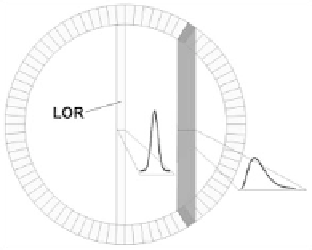Biomedical Engineering Reference
In-Depth Information
FIGURE 6.1: A schematic representation of the depth-of-interaction effect
in 2D-PET. Taken from [14].
the field of view (FOV) of a PET scanner. This is caused by the depth-of-
interaction effect (see Figure 6.1 for a schematic representation of this effect
in 2D, taken from [14]) or through the presence of gaps in the FOV (in the
case when the detectors are distributed over panels). In the axial direction,
LOR density will be less at the edges than in the middle of the FOV.
Traditionally, raw data consisted of the total number of measured prompts
and randoms acquired during acquisition per LOR. This data was rebinned
into a sinogram. The rebinning step is necessary in order to produce a con-
sistent and complete set of projection data that is put into the reconstruction
code. In order to put the measured data into a sinogram a trade-off between
counting statistics and sampling detail needs to be found (see, e.g., [7]). In
general the choices have been made by the manufacturer of the scanner. User
interaction is usually limited or even completely absent. The following quan-
tities can be discussed:
•
Not only coincidences within the same ring are taken into account, but
coincidences between adjacent rings as well. For an N ring scanner a
total of N direct + (N -1) indirect planes can thus be defined, with an
axial sampling equal to half the detector spacing. The term span is used
to indicate the amount of axial data combinations; the number refers
to the sum of the number of planes contributing to a direct plane and
the number of (cross-) planes contributing to an indirect (`interpolated')
frame.
•
Alternatively, radial bins can be combined in order to improve sinogram
sampling. A mashing factor of 1 implies that two angular samples are
taken together and attributed to the average angle of the two.
•
The maximum ring difference indicates the minimum angle between the
z-axis and a line of response that is still being taken into the sinogram
(an in-plane line of response lies perpendicularly to the z-axis). Usually,








Search WWH ::

Custom Search